
* In the early postwar period, aeronautical engineer Ted Smith developed a twin-prop executive aircraft, the "Aero Commander", which would prove popular, and evolve through a series of variants, ultimately resulting in the stretched, turboprop-powered "Turbo Commander". Rockwell acquired the Commander from Smith, who then went on to develop an improved follow-on, the "Aerostar", which was acquired by Piper. Rockwell continued to develop the Commander, and also acquired a grab-bag of other aircraft to sell under the Commander label. This document provides a history and description of the Aero & Turbo Commander, Aerostar, and the diverse Rockwell Commander line. A list of illustrations credits is given at the end.
* The Aero Design & Engineering Company was founded in Culver City CA in 1944 by Ted R. Smith, who had earlier been a project engineer at Douglas Aircraft. He left Douglas with a group of engineers that had worked on the Douglas A-20 and A-26 twin-engine bombers. The company was focused on development of a twin-engine light airliner, with the "Model L3805" performing its initial flight on 23 April 1948.
The L3805 was an all-metal high-wing monoplane with retractable tricycle landing gear, the prototype featuring two Lycoming O-435-A piston engines, providing 142 kW (190 HP) each and driving two-blade variable-pitch propellers. The prototype was evaluated by Beech and Fairchild, but neither firm decided to produce the machine; so Smith and company set up their own manufacturing facility near Oklahoma City, Oklahoma.
The production "Aero Commander 520" was rolled out in August 1951, this first machine being used as a demonstrator -- performing a flight to Washington DC with one prop removed and stowed. The Commander 520 featured more powerful geared GO-435-C2 Lycoming engines, providing 195 kN (260 HP) each, plus a taller tailfin and substantially increased fuel capacity. Total fuel capacity was 568 liters (150 US gallons), all in wing tanks. The "520" designation, incidentally, gave the summed horsepower of the two engines.
Descriptions of the seating arrangement are confusing, having varied considerably over the evolution of the Aero Commander. It appears that the basic seating arrangement was two bucket seats in the cockpit, with two bucket seats behind that. Optionally, there could be a bench seat in the rear; for two, maybe three passengers -- making total capacity four to seven seats. Rearmost bucket seats may have been an option, as was a sideways seat between the front and second rows, as an alternative to a third row of seats.
There was a entry door on the front left fuselage, a passenger door on the left under the forward part of the wing, and a baggage door on the left at the rear of the wing. All the doors were front-hinged. The aircraft was unpressurized. It was noted for good handling and short-field performance. Although the intent had been to sell the Commander 520 as a "feederliner", performing shuttles from small airports to larger hub airports, the type ended up being sold primarily as an executive aircraft.
150 Model 520s were built. Three of them were evaluated by the US Army, under the designation of "YL-26". The Army decided not to proceed with a larger buy at the time, with the three machines remaining in service, being redesignated "YU-9A" in 1962, when the Pentagon established uniform designation codes.
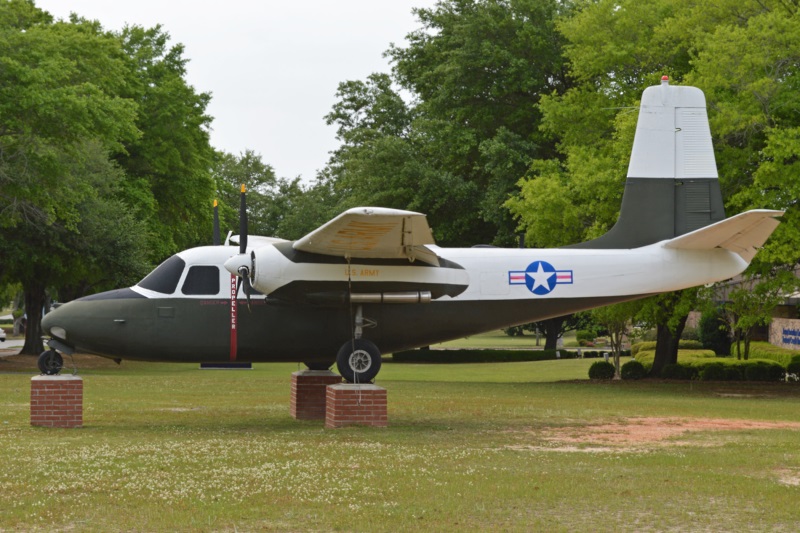
In 1954, the Commander 520 was replaced in production by the "Model 560", which had:
80 were built, with one evaluated by the US Air Force (USAF) as the "YL-26A", this machine being lost in a crash in 1955.
The Model 560 was followed by the "Aero Commander 560A", with refined GO-480-D1A engines in larger, aerodynamically cleaned-up nacelles; the nacelles were moved out 6 centimeters (2.5 inches) on the wings to reduce cabin noise. The Model 560 could also be obtained with uprated GO-480-C1B-6 engines, providing 220 kW (295 HP) for take-off. The fuselage was stretched by 25 centimeters (10 inches) forward of the wing -- apparently to allow more comfortable fit of a sideways seat or rear bench seat. In addition, the Model 560A featured redesigned and simplified main landing gear, plus various aerodynamic tweaks.
99 Model 560As were built, with 14 of them obtained by the USAF as the "L-26B", following up the single Model 520 that had been evaluated. Two were used by the White House -- typically to shuttle President Dwight Eisenhower to his residence in Gettysburg PA. One of the L-26Bs was transferred to the US Army; in 1962, the USAF L-26Bs were redesignated "U-4A", while the Army L-26B became the "U-9B".
The next in the series was the "Model 560E", which featured 76-centimeter (30-inch) tip extensions on each wing, permitting MTO to be increased by 180 kilograms (400 pounds). Landing gear was reinforced to handle the higher weights; uprated engines were available as an option. 93 Model 560Es were built. There was also a "Model 560F", with Lycoming IGO-540 engines providing 260 kW (350 HP) each -- over time, model numbers necessarily became more inconsistent with engine horsepower. 73 were built.
In parallel with the Model 560E, Aero developed a "Model 680 Super", with more powerful engines and substantially improved performance. The Model 680 and its descendants, including turboprop variants, are discussed below. Along with "more" in the form of the Model 680, Aero also pursued "less", developing the lightweight "Model 360" -- with 135 kW (180 HP) engines and apparently only four seats -- to compete with lower-cost twin-engine aircraft that had been introduced by competitors.
The Model 360 didn't work out, only a prototype being flown, but Aero persisted with the lightweight concept, introducing the "Model 500" in 1958. The Model 500 was effectively a lightweight version of the Model 560A, with Lycoming GO-540-A engines providing 185 kW (250 HP) each, and apparently limited to six seats because of load limits. 101 were built.
The Model 500 was complemented by the "Model 500A", with fuel-injected Continental IO-470-M engines providing 195 kW (260 HP) each. 99 were built, with production moving on to the "Model 500B", introduced in 1961, with fuel-injected Lycoming IO-540-B1A5 engines, providing 215 kN (290 HP) each. The IO-540s were in new slim-line nacelles, with exhaust gases routed over the wing to cut down on cabin noise. The landing gear was modified to pivot 90 degrees to fit into the new nacelles. 217 Model 500Bs were built.
In 1964, all the piston-engined Commanders still in production were replaced by the "Model 500U", the "U" standing for "utility". The Model 500U was effectively a Model 520B, with a squared-off tailfin and a modified "pointier" nose. Standard configuration was three rows of seats, but it could be configured with four rows; or as a cargo hauler, with all but the pilot's seat removed. It could carry a load of 1,010 pounds (2,230 pounds). A reinforced floor was available as an option. The Model 500U could also be used as a photo-survey aircraft. 56 baseline Model 500Us were built.

In 1965, Aero Commander became a division of the Rockwell International corporation. From 1967, the Model 500U, given some tweaks -- such as slightly improved IO-540-E1B5 engines, became the "Model 500S Shrike Commander", Rockwell having got the idea of naming the Commander aircraft after birds. It was the definitive "small" Aero Commander; 316 were built.
___________________________________________________________________
ROCKWELL MODEL 500S SHRIKE COMMANDER:
___________________________________________________________________
wingspan:
14.95 meters (49 feet)
wing area:
23.69 sq_meters (255 sq_feet)
length:
11.22 meters (36 feet 10 inches)
height:
4.42 meters (14 feet 6 inches)
empty weight:
2,100 kilograms (4,635 pounds)
MTO weight:
3,060 kilograms (6,750 pounds)
max speed, sea level:
345 KPH (215 MPH / 185 KT)
cruise speed:
325 KPH (205 MPH / 175 KT)
service ceiling:
5,915 meters (19,400 feet)
range:
1,735 kilometers (1,080 MI / 935 NMI)
___________________________________________________________________
Legendary airman Bob Hoover liked to fly his Shrike Commander at airshows, putting on remarkable performances with the aircraft. After his retirement in 2003, his Shrike Commander ended up on display at the Smithsonian National Air and Space Museum Udvar-Hazy Center, in Chantilly, Virginia.
BACK_TO_TOP* As mentioned earlier, in the late 1950s, the Aero firm decided to produce a high-powered version of the Commander, with first flight of the "Aero Commander 680 Super" prototype on 14 May 1960. It was effectively a Model 560A with twin Lycoming GSO-140-A1A-6 engines, featuring supercharging and 255 kW (340 HP) each, plus more fuel capacity. 254 were produced, including a number for the US military:
One of the RL-9Ds was passed on to the US Navy, being used for test and evaluation at the China Lake facility in California.
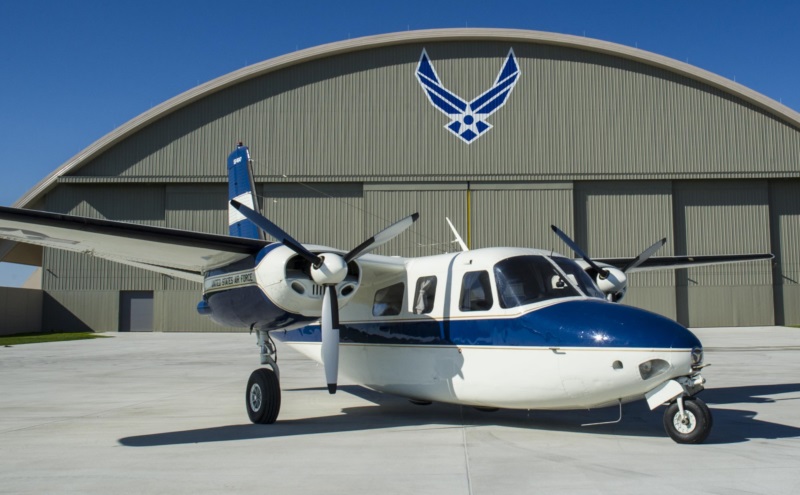
The baseline Model 680 was followed by improved variants:
The first turboprop variant of the series, the "Model 680T", was introduced in 1964, being a Model 680FL/P powered by Garrett AiResearch TPE331-43 engines, with 430 kW (575 SHP) each. 56 were built, being followed by refined versions:
A militarized version of the 680T, the "Expanded Mission Aircraft (EMA)" Commander, was offered. It was intended to be a light utility transport, capable of dropping paratroops, and carrying offensive weapons. It could also be configured for special missions, like photo survey or electronic warfare. There were no takers. The Model 680T was followed in turn by the "Model 690", which featured refinements such as:
79 were built, to also be followed by improved variants:
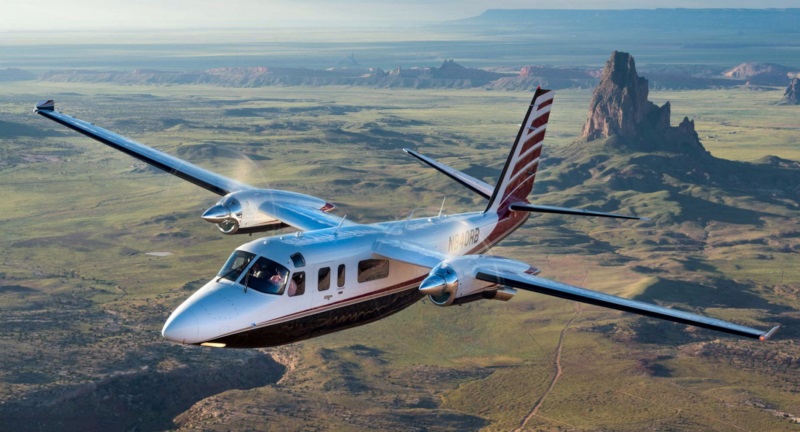
The Commander division had disappeared in a 1970 reorganization; Rockwell sold the product line to Gulfstream Aviation in 1981, which was in turn bought out by Chrysler in 1985. Gulfstream ended up focusing on jets, and so the last Commander was rolled out in 1986. Support and service of the Commander line was sold to Precision Aircraft Corporation, which became Twin Commander in 2003. The company calls the type, regardless of model, the Twin Commander.
___________________________________________________________________
ROCKWELL MODEL 695A JETPROP 1000A:
___________________________________________________________________
wingspan:
15.89 meters (52 feet 1 inch)
wing area:
25.95 sq_meters (255 sq_feet)
length:
13.10 meters (43 feet)
height:
4.45 meters (15 feet)
empty weight:
3,305 kilograms (7,290 pounds)
MTO weight:
5,080 kilograms (11,200 pounds)
cruise speed:
565 KPH (350 MPH / 300 KT)
service ceiling:
9,450 meters (31,000 feet)
range, max payload:
2,310 kilometers (1,435 MI / 1,245 NMI)
___________________________________________________________________
The Aero Commander series saw military use, largely in the utility role, with Argentina, Benin, Colombia, Greece, Indonesia, Iran, Ivory Coast, Kenya, Laos, Mexico, Niger, Pakistan, the Philippines, and South Korea. There are plenty of Aero Commanders still flying, with upgrades available, notably from the Twin Commander company.
BACK_TO_TOP* Ted Smith parted ways from the Aero Commander company some time after it was bought up by Rockwell, to start a new aircraft company, out of Van Nuys, California. The company focused on the "Aerostar", a new twin-piston design. The initial "Model 360" prototype performed its first flight in November 1966; it was powered by twin Lycoming IO-360 flat-four air-cooled fuel-injected engines with 130 kW (180 HP) each. It was then modified with 150 kW (200 HP) IO-360 engines, to become the "Model 400".
Initial flight of the first production "Aerostar 600" was in October 1967. Model 600s sold in Europe were known as "Model 600E", with the "E" suffix also designating European machines in later variants. A "Model 600A" -- "600AE" in Europe -- was introduced with minor tweaks, with a total of 282 Model 600s of all designations built.

The Model 600A provides a baseline for the family. It had a clear resemblance to the Aero Commander, differing most significantly in having a mid-mounted, instead of high-mounted, wing. It was powered by Lycoming IO-540-K1J5 flat-six engines with 215 kW (290 HP) each, driving three-bladed variable-pitch propellers. Fuel capacity was 625 liters (165 US gallons) in fuselage and integral wing tanks. The wing followed the same plan as that of the Aero Commander -- straight leading edge, swept trailing edge -- but the tail surfaces were swept. Flight control surfaces were conventional, including ailerons, one-piece flaps, rudder, elevators, and trim tabs. Controls were manually actuated, except for hydraulically-actuated flaps.
The Aerostar 600A had tricycle landing gear with hydraulic retraction, all gear assemblies with single wheels, the nose gear retracting backward, the main gear retracting inward from the wings. It had accommodations for six passengers in three rows of bucket seats. There was a split door on the forward left fuselage for access, and an emergency exit on the left rear fuselage. The Aerostar 600A had excellent performance for its class.
___________________________________________________________________
TED SMITH AEROSTAR 600A:
___________________________________________________________________
wingspan:
10.41 meters (34 feet 2 inches)
wing area:
15.79 sq_meters (170 sq_feet)
length:
10.61 meters (34 feet 10 inches)
height:
3.70 meters (12 feet 2 inches)
empty weight:
1,695 kilograms (3,737 pounds)
MTO weight:
2,495 kilograms (5,500 pounds)
cruise speed:
410 KPH (255 MPH / 220 KT)
service ceiling:
6,460 meters (21,200 feet)
range, max fuel:
1,820 kilometers (1,132 MI / 985 NMI)
___________________________________________________________________
A turbocharged "Aerostar 601" was introduced as well, with 117 built. The engines were not obtained from Lycoming with turbochargers, instead being added as part of aircraft construction. It was followed by the "Aerostar 601B", with wingspan increased from 10.41 meters to 11.18 meters (34 feet 2 inches to 36 feet 8 inches). 44 were built.
Aerostar was bought up by the American Cement Company in 1968. That worked out about as well as it might sound, with the operation sold in 1969 to Butler Aviation, the parent of Mooney Aircraft Company, with Smith's firm then named the "Aerostar Aircraft Corporation". That didn't work out well either, with Smith buying back rights to the aircraft in 1972, to continue production at a plant in Santa Maria CA, the company being renamed the "Ted Smith Aerostar Corporation". Smith introduced the "Aerostar 601P" after that -- preceded by a single "Aerostar 621" prototype -- being a 601B with more powerful turbochargers to drive cabin pressurization.
Smith died in 1976. The company was bought up by the Piper Aircraft Corporation in 1978, to continue to build the Aerostar 600A and 601B, and then the pressurized Aerostar 601P -- as well as the Piper-developed pressurized "602P Sequoia", with TIO-540-AA1A5 engines providing 215 kw (290 HP) each. 124 Model 602Ps were built.
Piper enhanced the Aerostar 602P with contra-rotating Lycoming TIO-540-U2A engines, redesignating it the "Model 700P", with 26 built. A "Model 702P" followed, it appears as a update, with reinforced nose gear to handle greater MTOW. Piper implemented its own model designations, in a somewhat confusing fashion:
Sources also mention a "Model 700 Superstar", which was a single prototype with a stretched fuselage and IO-540M engines; and a "Model 800", which was a Model 601P with a stretched fuselage, larger tail assembly, and twin Lycomings with 300 kW (400 HP) each; details are not clear, but only prototypes were flown.
Piper ended production of the Aerostar in 1984. 1,010 had been built, including 491 by Ted Smith and 519 by Piper. The Aerostar type certificate and manufacturing documentation were sold in 1991 to Jim Christy and Steve Speer, who had been part of the Ted Smith Aerostar operation. Christy and Speer sent up Aerostar Aircraft Corporation in Hayden Lake, Idaho, to support Aerostars in service.
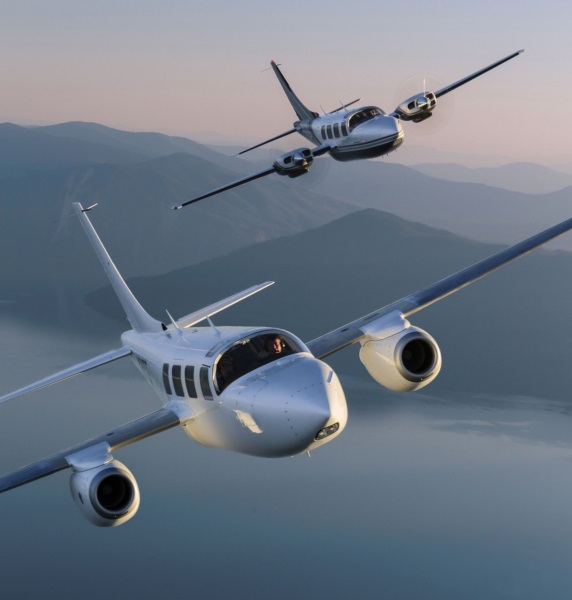
The firm offers comprehensive rebuilds and updates, with features such as uprated engines and a glass cockpit. The company even flew a turbofan-powered "Aerostar Jet" from 2011, with Pratt & Whitney PW615F engines. It appears that Smith designed the Aerostar from the outset to be readily adapted to piston, turboprop, or turbofan power. The company never got backing for it, so it didn't go into production.
BACK_TO_TOP* Rockwell obtained a number of designs of unrelated aircraft from smaller manufacturers, and marketed them under the "Commander" label -- though they had little or nothing to do with the Aero Commander.
The first of the series, the "Aero Commander 100", began life as the "Model 10 Volaire", built by Volaircraft of Aliquippa, Pennsylvania, which performed its first flight in 1960, leading to the production "Volaire 1035", with three seats, and "Volaire 1050", with four seats. The Volaire was a light aircraft of conventional configuration, a workmanlike if not particularly elegant design, being somewhat boxy and toylike in appearance. It featured:
The Volaire 1035 was powered by a Lycoming O-290-D flat-four air-cooled engine with 100 kW (135 HP), while the Volaire 1050 was powered by a similar Lycoming O-320-A engine with 110 kW (150 HP); a two-bladed fixed-pitch prop was used in either case. Sources suggest that only six Volaire 1035s were built, suggesting that the Volaircraft company never got the Volaire 1050 into production.
The Volaire design was bought up by Rockwell in 1965, with the Volaire 1050 and Volaire 1035 promptly going into production with minimal changes as the "Aero Commander 100" and "Aero Commander 100A" respectively. There's not much further mention of the 100A, and Rockwell may have not actually built any of them.
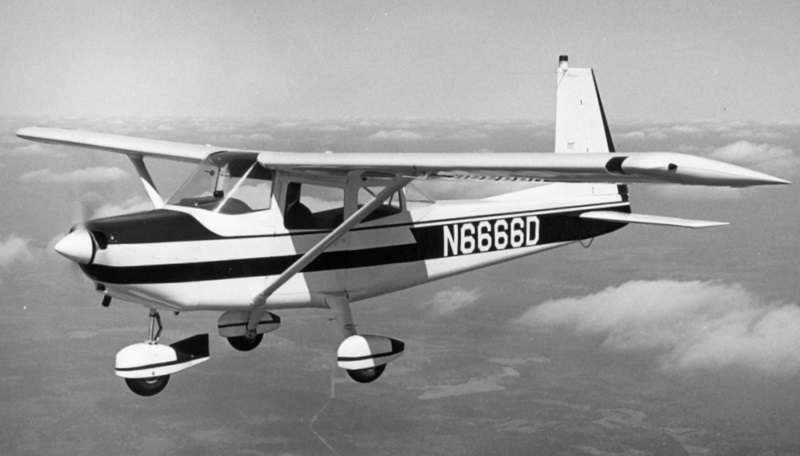
The Aero Commander 100 got a minor make-over in 1968, with alteration of the windshield and rear window, plus some other minor tweaks -- this variant becoming the "Darter Commander". The improved "Model 100-180 Lark Commander" quickly followed, being easily distinguished by a swept tailfin; it also had an O-360-A2F engine, with 135 kW (180 HP), a cleaned-up cowling, and higher MTO.
___________________________________________________________________
ROCKWELL MODEL 100-180 LARK COMMANDER:
___________________________________________________________________
wingspan:
10.67 meters (35 feet)
wing area:
16.8 sq_meters (181 sq_feet)
length:
6.86 meters (22 feet 6 inches)
height:
3.07 meters (10 feet 1 inch)
empty weight:
658 kilograms (1,450 pounds)
MTO weight:
1,110 kilograms (2,450 pounds)
maximum speed:
220 KPH (140 MPH / 120 KT)
cruise speed:
210 KPH (125 MPH / 115 KT)
service ceiling:
4,000 meters (13,000 feet)
range:
845 kilometers (524 miles / 455 NMI)
___________________________________________________________________
Although sturdy and docile, the Darter and Lark Commanders were not big hits, being unable to match the competition. Production of the Darter Commander ended in 1969, with that of the Lark Commander ending in 1971. Rockwell sold the rights to the two machines to Phoenix Aircraft, but the company did not restart production. About 355 Aero Commander 100 / Darters and 213 Larks were built in all, with many still in service.
* Following the introduction of the Lark Commander, Rockwell's Commander division focused on a more advanced four-seat piston aircraft design, with development conducted in parallel on the "Commander 111" and the "Commander 112" -- which were mostly identical designs, differing significantly in that they had fixed and retractable landing gear respectively. Initial flight of the first of five Commander 112 prototypes was on 4 December 1970; the first of two Commander 111 prototypes performed its initial flight in September 1971.
One of the Commander 112 prototypes was lost in a crash, delaying the program; deliveries of the Commander 112 began in 1972, the decision having been made not to put the fixed-gear Commander 111 into production. The Commander 100 had been a somewhat stodgy design; the Commander 112 was much sleeker and modern in appearance. It was a four-seat low-wing monoplane of all-metal construction, all landing gear having single wheels. The landing gear was of "trailing-link" configuration, ensuring softer landings. The Commander 112 was powered by a Lycoming IO-360-T4B5D fuel-injected flat-four engine with 150 kW (200 HP) -- prototypes had been fitted with a 135 kW (180 HP) O-360.
___________________________________________________________________
ROCKWELL COMMANDER 112:
___________________________________________________________________
wingspan:
9.98 meters (32 feet 9 inches)
wing area:
14.12 sq_meters (152 sq_feet)
length:
7.63 meters (25 feet)
height:
2.57 meters (8 feet 5 inches)
empty weight:
940 kilograms (2,070 pounds)
MTO weight:
1,480 kilograms (3,260 pounds)
maximum speed:
305 KPH (190 MPH / 165 KT)
cruise speed:
290 KPH (180 MPH / 155 KT)
service ceiling:
5,030 meters (16,500 feet)
range:
1,310 kilometers (815 miles / 705 NMI)
___________________________________________________________________
The aircraft was capacious and comfortable, as well as sturdy. However, its robust construction, in part a consequence of the crash of the prototype, also meant it was somewhat underpowered, and lagged in performance compared to competitors. Following production of 123 original Commander 112s, refined variants were introduced:
A total of about 1,000 Commander 112 / 114 machines was built to end of production in 1980. Rockwell sold the Commander line off to Gulfstream American in 1981; Gulfstream was only interested in the Turbo Commander, and didn't build any Commander singles.

However, in 1988 Gulfstream sold the rights to the 114 to one Randall Greene, whose "Commander Aircraft" built two more variants:
The Commander Aircraft company wanted to move on to a further improved Commander 115/115TC, but went broke in 2002, after having built about 200 Commander 115s. There has been some activity on restarting production again, but so far, it hasn't happened. Upgrades of machines still in service are available, including new engines, avionics, and interiors.
* Along with the Commander 100 series, Rockwell produced a "Commander 200" series. It was originally developed by one Al Meyers and his "Meyers Aircraft Corporation (MAC)", the series starting out with a "MAC-125" prototype, that being a two-seat aircraft with a 95 kW (125 HP) engine. The MAC 125 led to the "MAC-145" -- which was much the same, except for a 110 kW (145 HP) engine and a taller tailfin.
The MAC 145 was an all-metal low-wing aircraft, with taildragger landing gear; the main gear retracted in towards the fuselage, while the tailwheel was fixed, and steerable. It had an all-round vision canopy, with side-by-side seating, and a forward-hinged window / door on each side of the fuselage. Only 22 were built, including prototypes, from the late 1940s. In 1955, Meyers introduced the "MAC-200", which revised the MAC-145 design by going up to a 150 kW (200 HP) engine, providing four seats, car-style doors, and tricycle landing gear. It was extraordinarily sturdy. Meyers built a modest number of them, in several variants:
The MAC-200 looked like a good deal to Rockwell, which bought up rights to the machine in 1966, selling it as the "Aero Commander 200". That quickly turned out to be an error, since it wasn't designed to be mass-produced; all the Meyers machines were effectively hand-made to customer order.
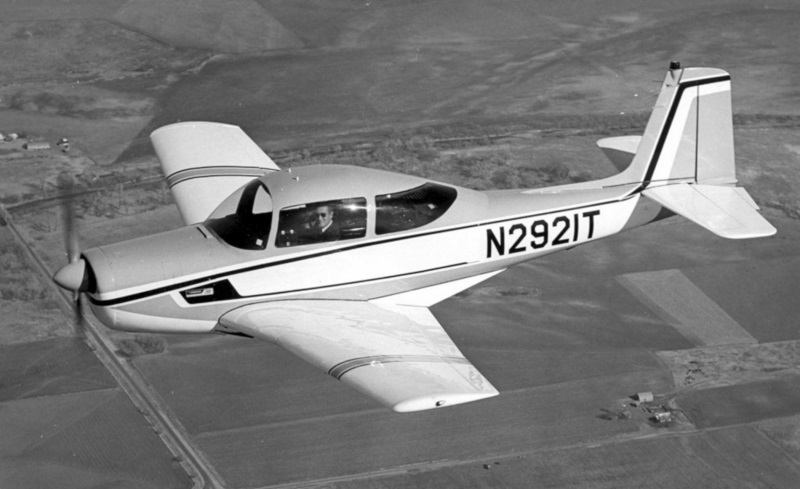
77 were built by Rockwell, plus a prototype of an improved variant -- but in 1968, Rockwell sold off rights to the MAC-200 to the Prop-Jets Corporation, later the Interceptor Corporation, which came up with a turboprop version, the "Interceptor 400".
___________________________________________________________________
ROCKWELL COMMANDER 200:
___________________________________________________________________
wingspan:
9.3 meters (30 feet 6 inches)
wing area:
15 sq_meters (162 sq_feet)
length:
7.42 meters (24 feet 4 inches)
height:
2.24 meters (7 feet 4 inches)
empty weight:
880 kilograms (1,940 pounds)
MTO weight:
1,360 kilograms (3,000 pounds)
maximum speed:
345 KPH (215 MPH / 185 KT)
cruise speed:
340 KPH (210 MPH / 180 KT)
service ceiling:
5,600 meters (18,500 feet
range:
1,400 kilometers (900 miles / 780 NMI)
___________________________________________________________________
The Interceptor 400 first flew in 1969. It was powered by a Garrett TPE331-1-101 turboprop, with 300 kW (400 SHP), driving a three-bladed Hartzell propeller. The Interceptor 400 never went into production; a militarized version, for light attack and other duties, never flew. The type certificate for the Meyers 200 / Interceptor 400 is still in circulation, but it doesn't seem likely any more of the family will be built.
* The last of the "other Commanders" was the "Commander 700", a piston twin. It started out in 1971 as a project by Fuji of Japan, the design originally being designated "FA-300". Progress was slow, and in 1974 Fuji established a collaboration with Rockwell to get the aircraft on the market, with Rockwell calling it the "Commander 700". The initial prototype first flew in Japan on 13 November 1975, with a Rockwell-assembled prototype following on 25 February 1976.

The Commander 700 was an all-metal aircraft, with:
The Commander 700 was seen as a roomy and comfortable aircraft, if somewhat underpowered, and its range was limited with a full passenger load.
___________________________________________________________________
ROCKWELL COMMANDER 700:
___________________________________________________________________
wingspan:
12.94 meters (42 feet 6 inches)
wing area:
18.6 sq_meters (200 sq_feet)
length:
12.03 meters (39 feet 6 inches)
height:
4.05 meters (13 feet 4 inches)
empty weight:
2,134 kilograms (4,704 pounds)
MTO weight:
3,151 kilograms (6,947 pounds)
maximum speed:
410 KPH (255 MPH / 220 KT)
cruise speed:
290 KPH (180 MPH / 155 KT)
service ceiling:
8,350 meters (27,400 feet
range:
2,225 kilometers (1,385 miles / 1,205 NMI)
___________________________________________________________________
Fuji designed an improved "Commander 710" with 335-kW (450 HP) engines, flying it in 1976 -- but as noted above, Rockwell sold off the general aviation division in 1979, with all rights to the design reverting to Fuji. Fuji had little interest in doing any more with it, and only 49 Fuji / Rockwell Fuji 700s were built in all. The "other Commanders" ended up being a family of aircraft with little distinction.
BACK_TO_TOP* Rockwell also sold two agricultural aircraft under the "Commander" label including the "Ag Commander A-9" and "Ag Commander S-2 Thrush", but they are better discussed as part of a document on agricultural aircraft.

* There's not a lot of formal writing on the Commander series, so I got this from the online Wikipedia and various other websites, plus such comments as I could find in aircraft encyclopedias.
* Illustrations details:
* Revision history:
v1.0.0 / 01 mar 20 v1.0.1 / 01 jan 22 / Review & polish. v1.0.2 / 01 jan 24 / Review & polish. (+)BACK_TO_TOP
